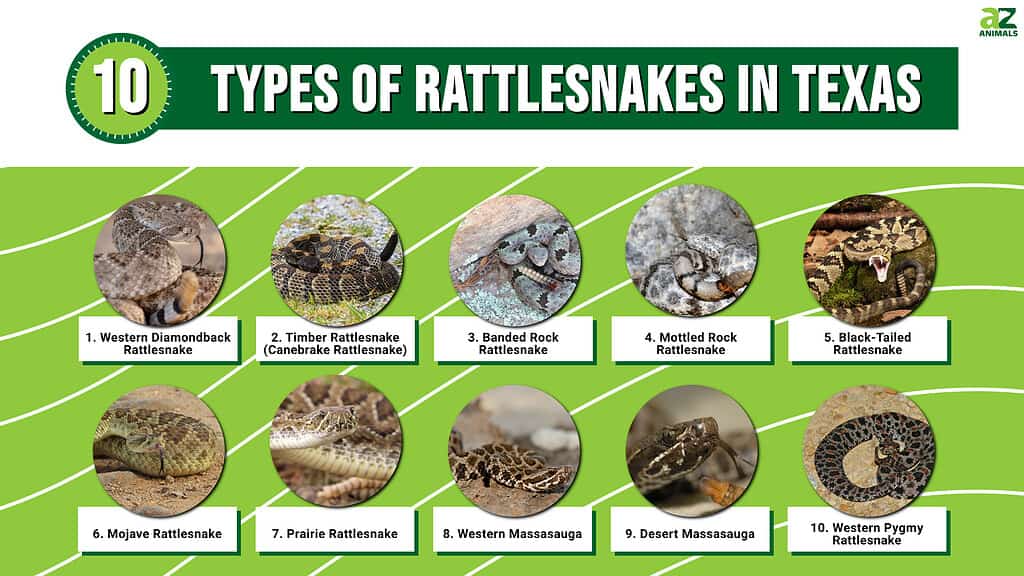
Rattlesnakes in Texas are practically part of the landscape, living anywhere from rocky desert canyons to your own backyard. Starting in late February and early March, the weather in Texas warms up enough for rattlesnakes to come out and enjoy the sun.
Although rattlesnakes will be out and about throughout the summer, you are most likely to see them during their mating season in the spring. This is also when they tend to be more aggressive and defensive. Rattlesnakes return to their dens for brumation when it starts getting cold again in September.
So, what kinds of rattlesnakes live in Texas?
What Types Of Rattlesnakes Are In Texas?
Texas is home to 10 different types of rattlesnakes, and more than 90 types of snakes total! So that makes it the state with the second-highest number of rattlesnakes in the U.S. (following Arizona, which has 13). Three of these rattlesnake species are protected under the state laws of Texas: the timber rattlesnake, the banded rock rattlesnake, and the mottled rock rattlesnake.
Most rattlesnakes in Texas are rarely aggressive, but if they feel threatened or in danger, they certainly will defend themselves with brutal force. Let’s take a closer look at the 10 types of rattlesnakes in Texas.
1. Western Diamondback Rattlesnake

The western diamondback rattlesnake has very distinct black and white bands along the end of its tail.
©Alexander Wong/Shutterstock.com
| Western Diamondback Rattlesnake | |
|---|---|
| Range | Everywhere except for the northern Panhandle and some of eastern Texas |
| Size | 48-72 inches (4-6 feet long) |
The western diamondback rattlesnake is the most common venomous snake in Texas. Thus, his rattlesnake lives in a variety of habitats all over the state, pretty much everywhere except for the northern Panhandle and some parts of eastern Texas. When you think of rattlesnakes in Texas, the western diamondback is likely what you’ll picture. This snake is an iconic image in many old western films.
The western diamondback causes the most rattlesnake bites in Texas. That’s because the western diamondback rattlesnake is aggressive, unlike many of the other snakes on this list. In fact, it may be the most aggressive of all rattlesnakes. This snake is not one to run from threats and will stand its ground in the face of danger.
Western diamondback rattlesnakes are usually 4-6 feet long and can live for over 20 years. They are mostly gray with darker diamond patterns running along the length of their bodies. The diamond on their backs have white or yellow outlines, and there are black and white bands on the end of the snake’s tail just before the rattle.
2. Timber Rattlesnake (Canebrake Rattlesnake)

Timber Rattlesnakes use camouflage to hide from predators.
©Frode Jacobsen/Shutterstock.com
| Timber Rattlesnake | |
|---|---|
| Range | Eastern third of Texas |
| Length | 36-40 inches |
The timber rattlesnake, or canebrake rattlesnake, lives mostly in the eastern third of Texas in areas where it can be close to water. These snakes are generally 36-40 inches long, but can grow past 5 feet, and are found in many regions of the eastern United States.
Timber rattlesnakes are usually gray, light yellow, or even a greenish-white color. Also, they have dark, jagged V-shaped bands along the length of their bodies, often with a rust or orange-colored stripe running down the middle of their backs as well. But the very end of the timber rattlesnake’s tail is dark near its rattle.
The timber rattlesnake is one of the most dangerous snakes in the United States, in part because they have such a high venom yield (they can inject a lot of venom in a single bite). These snakes eat rodents, amphibians, lizards, and even birds. Some reports in Texas suggest that these rattlesnakes especially like eating garter snakes.
Timber rattlesnakes are not always quick to defend. They prefer to stay silent and blend into their environment or escape rather than risk a fight. It can be hard to actually get these snakes to bite or even rattle a warning—although obviously it still happens, and you should never attempt to do so. Because timber rattlesnakes are a threatened species in Texas and are protected by state laws.
3. Banded Rock Rattlesnake
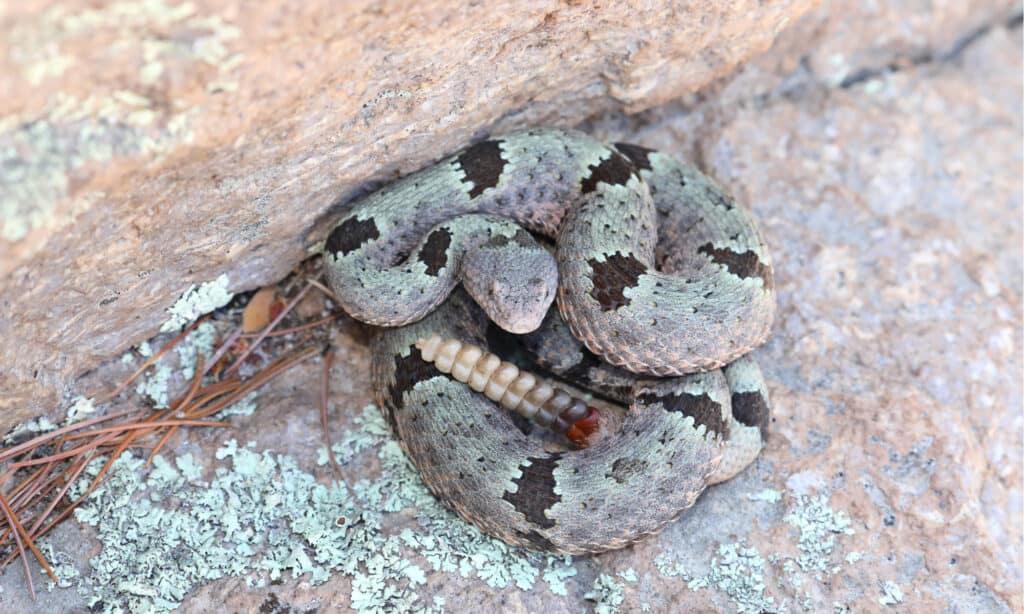
The Banded Rock Rattlesnake doesn’t travel very far and usually lives its entire life in the same area.
©Glenn McCrea/Shutterstock.com
| Banded Rock Rattlesnake | |
|---|---|
| Range | Western tip of Texas |
| Length | 23-27 inches |
The banded rock rattlesnake is found in the western tip of Texas, usually in rocky areas like canyons. Its habitat extends to the U.S. states of New Mexico and Arizona, as well as parts of Mexico. The banded rock rattlesnake is 23-27 inches long with a gray or dark green body. Like its name, this rattlesnake has dark gray or black bands patterned along the length of its body, giving it a very striking and unique appearance. Banded rock rattlesnakes are protected from capture of any kind by Texas state laws.
The banded rock rattlesnake is the least aggressive of all the rattlesnakes in Texas, therefore these snakes are shy and do their best to avoid large predators and humans. In fact, these snakes usually don’t hiss or even use their rattles, preferring instead to simply stay quiet and blend into their surroundings. The banded rock rattlesnake’s venom seems to vary depending on where it lives, but it is usually hemotoxic, attacking red blood cells.
4. Mottled Rock Rattlesnake
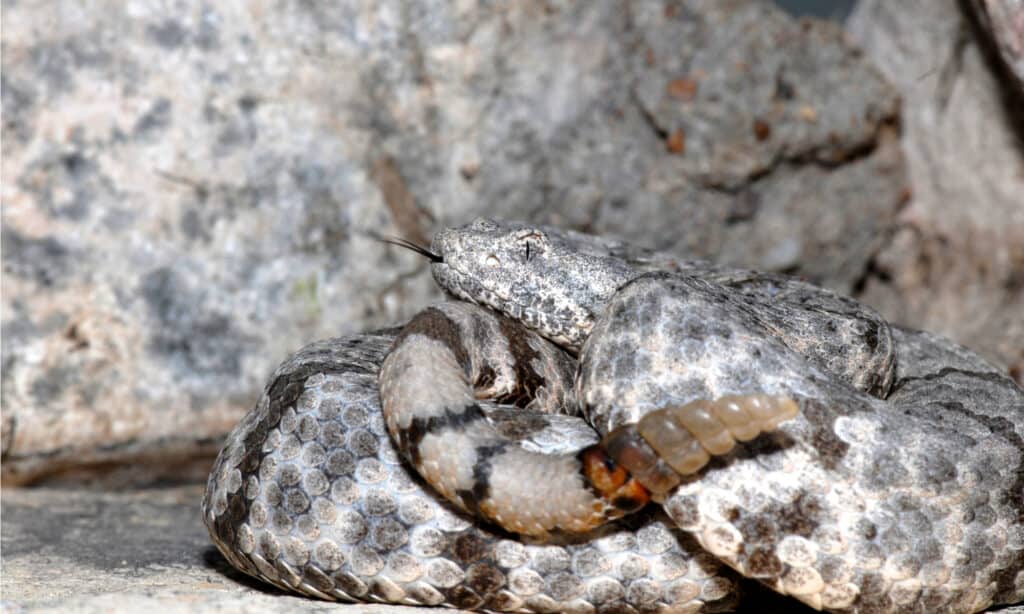
The Mottle Rock Rattlesnake can handle cold weather better than most other rattlesnakes.
©Rusty Dodson/Shutterstock.com
| Mottled Rock Rattlesnake | |
|---|---|
| Range | Western Texas |
| Length | 18-36 inches |
The mottled rock rattlesnake lives in the mountains and rocky areas of western Texas. This snake is a subspecies of the rock rattlesnake, measuring between 18-36 inches long. Due to its environment, the colors and patterns of mottled rock rattlesnakes help them to blend in seamlessly with their surrounding environment. So these snakes are often the pinkish or rust color of the rocks in their habitat. There are dark bands along the length of the snake’s body, as well as numerous and small, scattered splotches that give it its namesake “mottled” appearance.
Mottled rock rattlesnakes are not typically aggressive and may not even rattle a warning unless a threat is very close to them. These blend into the surrounding environment with their excellent camouflage and try to avoid humans and large animals whenever possible. However, mottled rock rattlesnakes do have potent venom with dangerous hemotoxins. Finally, like the banded rock rattlesnake, the mottled rock rattlesnake is protected from capture of any kind by Texas state laws.
5. Black-Tailed Rattlesnake
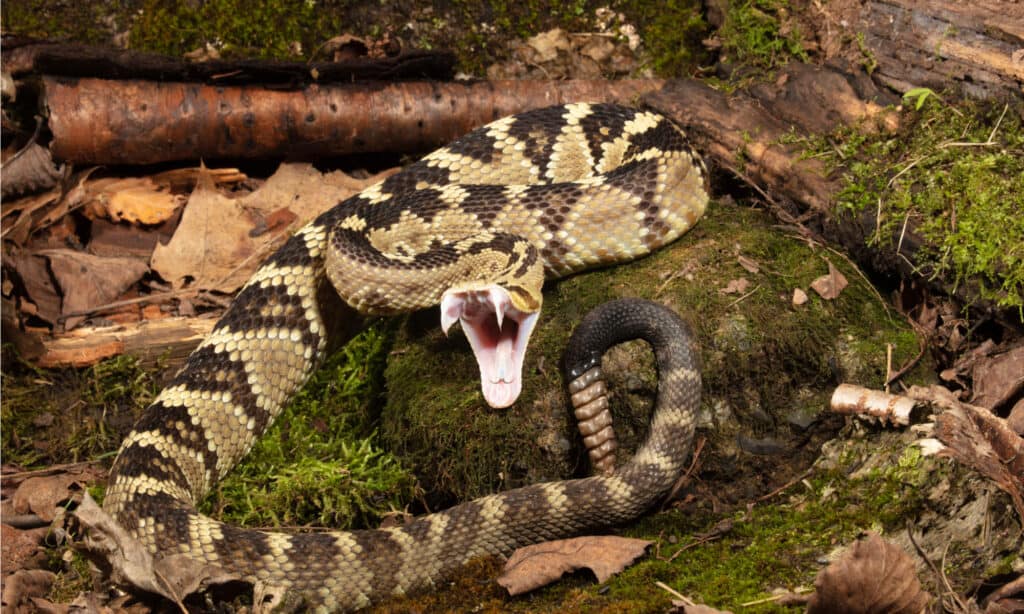
The Black-Tailed Rattlesnake is sometimes called the “dog-faced rattlesnake,” the “dog-headed rattlesnake”, the “velvet-tail rattlesnake”, or the “green rattler.
©Joe McDonald/Shutterstock.com
| Black-Tailed Rattlesnake | |
|---|---|
| Range | Central and West Texas |
| Length | 30-42 inches |
The black-tailed rattlesnake lives in central and west Texas, the southwestern United States, and Mexico. These snakes are typically some of the most docile rattlesnakes with a calm and curious nature. Black-tailed rattlesnakes may vibrate the rattle on the end of their tails as a warning if they feel threatened, but generally they prefer to blend into their surroundings with their camouflage, or quickly crawl away if necessary. Although these snakes are not typically aggressive, they are still dangerous with potent hemotoxic venom.
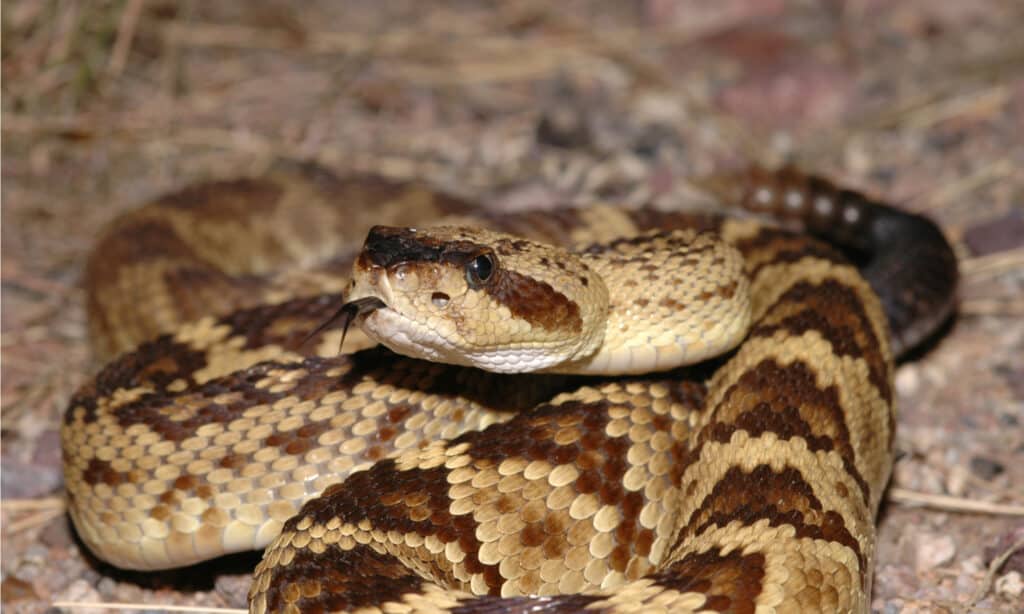
The “mask” of a black-tailed rattlesnake
©Rusty Dodson/Shutterstock.com
Black-tailed rattlesnakes have gray, silver, olive, or yellowish-colored bodies that measure 30-42 inches long. Additionally, dark diamond-shaped bands with light-colored borders run down the middle of the snake’s back, ending in a black or dark gray tail. The snake’s face is also marked with a dark band across its eyes like a mask.
6. Mojave Rattlesnake

The Mojave rattlesnake, including both of its subspecies, typically grows to between 3.3 ft and 4.5 ft in length.
©Creeping Things/Shutterstock.com
| Mojave Rattlesnake | |
|---|---|
| Range | Extreme far west regions of Texas |
| Length | 39-54 inches |
The Mojave rattlesnake only lives in parts of Texas, mostly in the extreme far west regions of the state. However, this snake can also be found ranging from central Mexico to the southwest United States primarily in desert areas. Although they mostly reside in upland deserts, Mojave rattlesnakes can also be found in shrubby landscapes, grasslands, and forests. There, they hunt lizards, birds, and small mammals.
Mojave rattlesnakes have triangular heads and brown bodies with greenish hues, measuring between 39-54 inches long. Additionally, along their backs are dark diamond markings, ending with white banded marks on their tails.
Despite being quite skittish, Mojave rattlesnakes have some of the most dangerous venoms in North America.
Scientists grouped them into two venom groups, calling them Venom A and Venom B. Venom A contains Mojave toxin, while Venom B doesn’t. Which snake has it? You can’t tell by looking. In any case, they’re the only snake in the U.S. that contains this neurotoxin.
So, some Mojave rattlesnakes’ venom contains both hemotoxins that attack the circulatory system, as well as neurotoxins that attack the nervous system. Although this snake is extremely dangerous, bites can be treated with anti-venom.
7. Prairie Rattlesnake

Prairie rattlesnakes spend most of their time slithering on the ground but they can also climb trees, navigate bushes, and are known to hide in rock crevices or small caves.
©Nina B/Shutterstock.com
| Prairie Rattlesnake | |
|---|---|
| Range | Western half of Texas |
| Length | 35-45 inches |
The prairie rattlesnake is only found in the western half of Texas, sometimes in the Trans-Pecos region but mostly in the Panhandle grasslands. These snakes grow between 35-35 inches with brown, gray, or green bodies. There are also dark brown oval-shaped patches with thin white borders along the middle of the snake’s back. Then, toward the end of the snake’s tail, these oval markings shift into dark rings. Plus, prairie rattlesnakes have keeled or ridged scales that make them look rough and bristly.
The venom of a prairie rattlesnake contains hemotoxins that attack red blood cells, and some neurotoxins that attack the nervous system. These snakes eat small mammals like mice, ground squirrels, prairie dogs, small rabbits, and rats. They also eat ground-nesting birds, small reptiles, and amphibians on occasion.
8. Western Massasauga

The western massasauga rattlesnake gets its name from the Chippewas language. “Massasauga” in Chippewas means “great river mouth.”
©Rusty Dodson/Shutterstock.com
| Western Massasauga | |
|---|---|
| Range | North-Central Texas |
| Length | 14-36 inches |
The western massasauga is a rattlesnake that lives only in the north-central part of Texas. Its habitat also stretches across the midwestern United States in prairies and grassland areas. This is a calm rattlesnake that sleeps much of the day and is usually only seen at night. And unfortunately, the western massasauga is a candidate for federal listing under the U.S. Endangered Species Act.
Western massasaugas are one of the smaller rattlesnakes, measuring between 14-36 inches long. These rattlesnakes are usually a light color with wide, dark blotches running along their backs. But one of their most distinctive features is a dark stripe that runs along each cheek, from the eye to the back of the mouth.
The western massasauga is a calm snake and doesn’t tend to rattle its tail right away. When it does rattle, the sound is much different from other rattlesnakes. The rattle of the western massasauga has very fast vibrations that make it sound much more high-pitched than other rattlesnakes. This unique high-pitched rattle is why this snake has been nicknamed the “Buzztail.” Western massasauga rattlesnakes have somewhat less potent venom, but it still has dangerous hemotoxins that break down blood cells.
9. Desert Massasauga
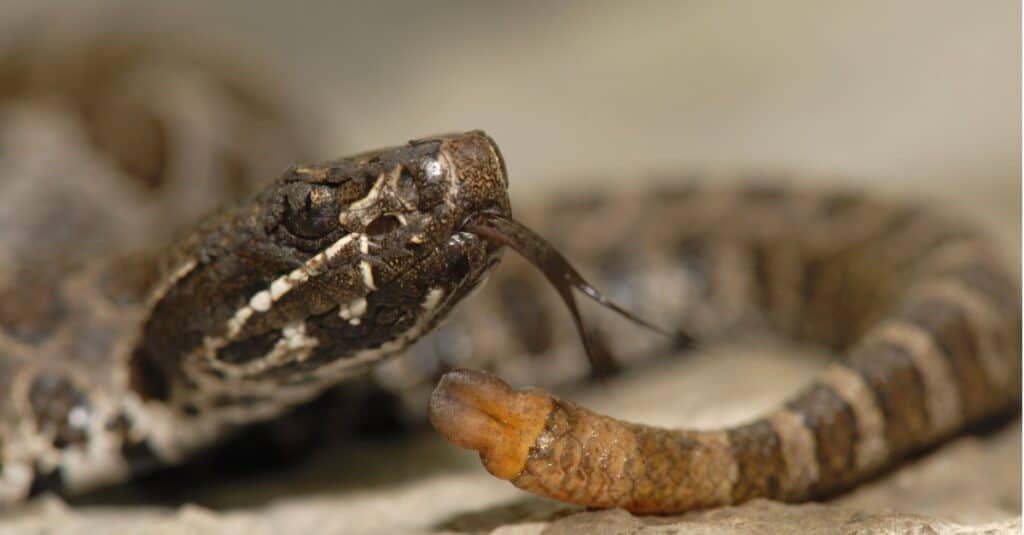
The desert massasauga rattlesnake is the smallest of the three subspecies of massasauga snakes.
©iStock.com/Shoemcfly
| Desert Massasauga | |
|---|---|
| Range | Northwest Texas & Southern tip of Texas |
| Length | 21 inches |
The desert massasauga is a subspecies of the western massasauga that inhabits northwest Texas and the southern tip of Texas, especially in the Rio Grande Valley. Thus, this snake prefers to live in similarly dry, rocky areas. The desert massasauga is a smaller rattlesnake, usually less than 21 inches long. Its base color is usually tan or gray, with large, brown blotches lined close together down the middle of its back. But it has a dark brown stripe along its cheek on both sides of the face, from the eye to the back corner of the mouth. There is also a very narrow white line just below this dark cheek stripe.
The desert massasauga is not an aggressive rattlesnake. It prefers to slither away from threats and danger rather than defend or attack. The desert massasauga’s venom is extremely potent, even more so than many larger rattlesnakes. However, it has a very low venom yield, which means that there is not a lot of venom in each bite. But it shouldn’t be underestimated, because the venom of the desert massasauga has very powerful cytotoxins which can cause severe pain, swelling, and necrosis.
10. Western Pygmy Rattlesnake
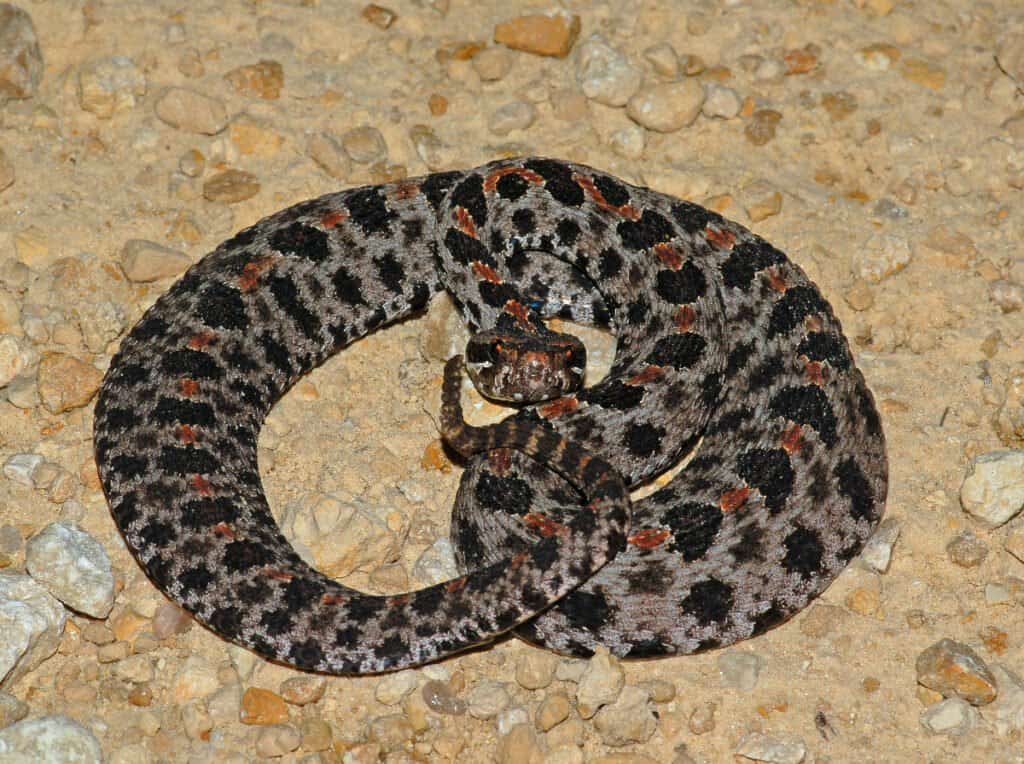
The western pygmy rattlesnake uses its tail to lure in prey like skinks.
©Gerald A. DeBoer/Shutterstock.com
| Western Pygmy Rattlesnake | |
|---|---|
| Range | East Texas |
| Size | 16-24 inches |
The western pygmy rattlesnake is scattered throughout East Texas, as well as many other southeastern states in the U.S. This rattlesnake is small, usually only 16-24 inches long. Its base color is gray with dark, oval-like blotches running close together along the middle of its back and then along the sides of its body. The western pygmy rattlesnake also has a rust or orange-colored stripe running along the middle of its back, giving it a very colorful and striking appearance. Its head is wide with a black stripe along each cheek, running from each eye to the back corner of its mouth.
Another unique feature of the western pygmy rattlesnake is its unusually small rattle. Its rattle is so small compared to other rattlesnakes, that locals in Texas nicknamed it the “rattle-less ground rattler.” The western pygmy rattlesnake eats insects, birds, lizards, small mammals, snakes, frogs, and is especially known for eating giant desert centipedes. The venom of the western pygmy rattlesnake is cytotoxic, breaking down cells and causing hemorrhaging. Medical researchers used western pygmy rattlesnake venom when creating eptifibatide, an anti-clotting drug often given when someone experiences a heart attack.
The 10 Types Of Rattlesnakes In Texas Summary
| Rank | Snake Name |
|---|---|
| #1 | Western Diamondback Rattlesnake |
| #2 | Timber Rattlesnake |
| #3 | Banded Rock Rattlesnake |
| #4 | Mottled Rock Rattlesnake |
| #5 | Black-Tailed Rattlesnake |
| #6 | Mojave Rattlesnake |
| #7 | Prairie Rattlesnake |
| #8 | Western Massasauga |
| #9 | Desert Massasauga |
| #10 | Western Pygmy Rattlesnake |
Animals That Live In Texas

The Screaming hairy armadillo is one of the smallest and most slender species of its genus. The adjective “screaming” in the name derives from their habit of squealing when handled or threatened. It is also an animal found in Texas.
©crbellette/Shutterstock.com
Texas is home to a wide variety of animals, from the iconic longhorn cattle to the elusive mountain lion. With diverse ecosystems ranging from grasslands to deserts to forests, Texas provides habitats for a broad array of animal species.
Here are a few examples of animals that call Texas home:
- Armadillos: These armored mammals are common throughout Texas, and are easily recognized by their distinctive, shell-like covering. Armadillos are omnivorous and primarily feed on insects, but they will also eat small reptiles and mammals.
- White-tailed deer: One of the most recognizable animals in Texas, the white-tailed deer is a common sight throughout the state. These herbivores feed on grasses, leaves, and twigs, and are an important prey species for many predators.
- Bobcats: These small wildcats are found throughout Texas, primarily in wooded areas. They are opportunistic predators, feeding on a variety of small mammals and birds.
- Western diamondback rattlesnakes: One of several venomous snakes found in Texas, the western diamondback rattlesnake is easily recognized by its distinctive diamond-shaped pattern on its back. These snakes are primarily found in dry, rocky habitats, and are important predators in their ecosystems.
- American alligators: These large reptiles can be found in several areas of Texas, particularly in wetland habitats. Alligators are apex predators in their ecosystems, feeding on fish, amphibians, and small mammals.
- Red-tailed hawks: These large birds of prey are common throughout Texas, and are easily identified by their distinctive red tail feathers. They are skilled hunters, feeding on small mammals and birds.
These are just a few examples of the many fascinating animal species that call Texas home. Whether you’re exploring the grasslands, forests, or deserts of the state, you’re sure to encounter a wide variety of wildlife along the way.
The photo featured at the top of this post is ©
Discover the "Monster" Snake 5X Bigger than an Anaconda
Every day A-Z Animals sends out some of the most incredible facts in the world from our free newsletter. Want to discover the 10 most beautiful snakes in the world, a "snake island" where you're never more than 3 feet from danger, or a "monster" snake 5X larger than an anaconda? Then sign up right now and you'll start receiving our daily newsletter absolutely free.
Thank you for reading! Have some feedback for us? Contact the AZ Animals editorial team.







